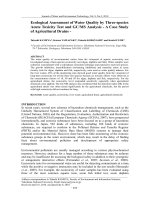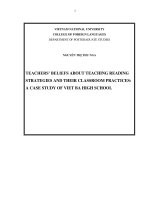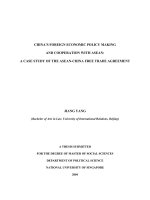Multinational corporations on the benefits of CSR and challenges of CSJ: A case study of Nestle
Bạn đang xem bản rút gọn của tài liệu. Xem và tải ngay bản đầy đủ của tài liệu tại đây (167.02 KB, 18 trang )
<span class="text_page_counter">Trang 1</span><div class="page_container" data-page="1">
<i><b>II. Literature Review...4</b></i>
<b><small>II. 1.Prior Knowledge and Research Gap...4</small></b>
<b><small>II. 2.The concept...8</small></b>
<small>II. 2. 1.Corporate social responsibility (CSR)...8</small>
<small>II. 2. 2.Corporate Social Justice (CSJ)...9</small>
<b><small>II. 3.The relationship between CSR and CSJ, the case of using child labor...9</small></b>
</div><span class="text_page_counter">Trang 2</span><div class="page_container" data-page="2"><b>Multinational corporations on the benefits of CSR andchallenges of CSJ: A case study of Nestle</b>
<b>I. Introduction</b>
<i><b>I.1. Background</b></i>
Studies have indicated that businesses with successful Corporate Social Responsibility (CSR) initiatives generate higher profits than those without such initiatives. In order to strengthen their brand and please consumers, businesses have depended on these initiatives for the past 50 years. These initiatives include diversity and inclusion work, employee volunteerism, philanthropic endeavors, and social issues marketing(Lily Zheng, 2020). But standards have been gradually raised in today's society. George Floyd was killed in Minneapolis by a white police officer, sparking one of the biggest protest movements in recent memory (Evan Hill et al., 2020), and the general outcry against the conventional CSR playbook indicates that outdated best practices might not be as useful as they once were. These days, what I refer to as "Corporate Social Justice (CSJ)" is what customers and employees want more than just Corporate Social Responsibility.
A multinational corporation based in Switzerland, NESTLÉ specializes in businesses that process food and beverages. Anglo-Swiss Milk Company was merged to form the Nestlé Company in 1905. Henri Nestlé founded it, along with George and Charles Page and Farine Lactee Nestlé in 1899. The main office is in Vevey, Switzerland's Vaud region. With a ranking of 64th in the 2017 Fortune Global 500 and 33rd in the 2016 Fortune Global 2000 public companies list, it is the largest food company in the world. 447 companies make up the company. There are roughly 339,000 workers and 189 different countries where machines are situated(McKerahan, 2024.) This case study delves into Nestlé's journey in adopting CSR initiatives that generate revenue, profit for the company and promote social responsibility, while navigating to a remarkable event due to the the development context of Corporate Social Justice (CSJ), specifically the case of Nestlé being accused of modern slavery in the form of child labor (Cartier, 2022). In this case, 8 children perceived they were being used slave labor in the cocoa industry in the Ivory Coast.
</div><span class="text_page_counter">Trang 3</span><div class="page_container" data-page="3"><i><b>I.2. Research Problems</b></i>
Corporate Social Responsibility (CSR) has grown in significance for businesses over the past few years. CSR is a topic that is frequently discussed in both the business and academic domains (Samuel O. Idowu et al., 2015). CSR has become an almost inseparable part of multinational corporations. The purpose of implementing CSR is to build the company's brand and create positive values for the social community. However, with the events that have occurred in recent years, too much focus on CSR has led to a lack of recognition of corporate social justice (CSJ). Implementing CSR is necessary, but if we forget about CSJ, it will cause imbalance for businesses and society.
The Nestle Group has worked hard to engage in CSR initiatives in recent years, particularly in the areas of labor and human rights, but they haven't always met their obligations. It might be important to examine how modern slavery is discussed in a particular context in order to comprehend why it continues to be a complicated and hidden issue. Very little research has been done on the topic of modern slavery and the role of MNCs, despite the fact that many books and articles have been written on the subject.
<i><b>I.3. Objectives</b></i>
Previous research articles mainly studied CSR so there are still limitations on CSJ. Many multinational companies have been accused of exploiting and exploiting child labor such as the event: "Mars, Nestlé and Hershey face child slavery lawsuit in the US" (Oliver Balch, 2021), and it is unclear why MNCs are able to avoid being involved in modern slavery and why there isn't more being done to end it. CSJ research on child labor inequality and how discussing it can help gain new insights. Therefore, the objective of this study is to go beyond talking about the advantages of CSR and supplement the existing knowledge by studying how to discuss the event "Nestle was accused of using child labor in its wages". Cocoa harvest in Africa's Ivory Coast"
<i><b>I.4. Relevance</b></i>
As stated previously, the topic of corporate social justice has been overlooked by many and has not been thoroughly researched. Therefore, studying the CSJ activities of MNCs in the form of child slavery on this issue is practically relevant now. This will highlight the importance of this topic and make it better known so that more research can be done on the topic.
</div><span class="text_page_counter">Trang 4</span><div class="page_container" data-page="4"><i><b>I.5. Outline</b></i>
This article is divided into five major parts. The next section will include a literature review that will detail the literature reviews to understand the existing research and perspectives related to Nestle and Corporate Social Justice, providing perspectives by previous scholars to add to the understanding of the subject. The third part explains the research methodology used, along with clarifying the collection and analysis of events that occurred at the company. The fourth chapter presents the results of the analysis and discusses social issues. The final chapter will draw conclusions based on the results of chapter four. and discuss conclusions and recommendations for future research.
</div><span class="text_page_counter">Trang 5</span><div class="page_container" data-page="5"><b>II. Literature Review</b>
<i><b>II.1. Prior Knowledge and Research Gap</b></i>
Although significant progress has been made in understanding the role of Corporate Social Responsibility (CSR) in multinational corporations (MNCs), there are still notable gaps in knowledge and area that needs further research. Additionally, the emerging discourse on Corporate Social Justice (CSJ) introduces new dimensions and complexities that require deeper exploration. This section highlights some key gaps in the existing literature and identifies future research directions. Although CSR has been widely studied, research on the integration of CSR and CSJ frameworks in the context of MNCs remains limited. Existing studies often consider CSR and CSJ as separate constructs, ignoring their linkages and potential synergies. Future research should explore how MNCs can effectively integrate CSR and CSJ principles into corporate strategy and operations to achieve comprehensive sustainability goals.
There is growing recognition of the importance of intersectionality and diversity in CSR and CSJ discourse. However, existing research often ignores the intersecting aspects of social identity, such as race, gender, ethnicity, and socioeconomic status, in shaping social impact and behavior. micro-enterprise of MNC. Future research should adopt an intersectional lens to examine how intersecting forms of privilege and marginalization influence MNCs' CSR and CSJ strategies and outcomes.
<b>Table 1. Previous studies on multinational companies implementing CSR and CSJ</b>
<b>GapResults/ FindingsSolutions</b>
1 Nestlé’s war on two fronts: A case study into the child labour accusations against times when they were using child address the root causes of child labor in cocoa farming, including the
</div><span class="text_page_counter">Trang 6</span><div class="page_container" data-page="6">study will also be traceability, and establish social projects. However, TNCP is not yet at a scale to effectively help the Ivorian people, and it lacks clear goals. While Nestlé aims to improve cocoa farm quality and efficiency, some argue it may prioritize its own profits over fair pay for lies partly with consumers and auditing bodies, although Nestlé has been criticized for not fully acknowledging failures. Responsibility for combating child labor is seen as shared among various actors, including
</div><span class="text_page_counter">Trang 7</span><div class="page_container" data-page="7">labor and its definition is vital, with Nestlé and others developing monitoring systems to address this. However, Nestlé has faced regulation are seen as key steps, not only for addressing human rights issues but also for building consumer trust and meeting demands for responsibly sourced products.
2 A sticky chocolate problem: Impression management and counter accounts in the shaping of corporate image
(Perkiss et al., 2021)
The broader fight against child labor and forced labor is not being won,
</div><span class="text_page_counter">Trang 8</span><div class="page_container" data-page="8">going in and out every day, small samples may not still narrow. The
This article aims
</div><span class="text_page_counter">Trang 9</span><div class="page_container" data-page="9">survey was only creating its own laws and acting
<i><b>II.2. The concept</b></i>
<i>II.2.1. Corporate social responsibility (CSR)</i>
There is a wide range and complexity in the definition of corporate social responsibility. H.R. Bowen, an expert in organizational research, first mentioned the term "corporate social responsibility" in his book "Social responsibilities of the Businessmen" almost fifty years ago. According to Bowen, corporate social responsibility is the duty of business owners to protect the rights and interests of others. They also have a duty to be altruistic and make up for any losses their companies cause when they negatively impact society (Bowen, 2013). The most complete and popular model of corporate social responsibility among the many available is the CSR (Corporate Social Responsibility) pyramid model developed by A. Carroll in 1991. Consequently, there are four categories of business societal responsibilities
</div><span class="text_page_counter">Trang 10</span><div class="page_container" data-page="10">that can be distinguished: legal, ethical, charitable, and economic. Numerous facets of society are impacted and influenced by these four groups, including communities, investors, workers, consumers, customers, and other stakeholders (Carroll, 1991).
<i>II.2.2. Corporate Social Justice (CSJ)</i>
In the past, businesses employed corporate social responsibility as a strategy to address racism and socioeconomic disparities. "CSR is a self-regulated framework that has no legal or social obligation for corporations to actually create positive impact for the groups they purport to help," as the Harvard Business Review puts it. The leadership of the company, investors, staff, and anybody else with a stake in the agency are all involved in corporate social justice, on the other hand. This new strategy "requires deep integration with every aspect of the way a company functions" in order to address systemic inequality. Institutions are working with the Center for Justice Research (CJR) to create their own Corporate Social Justice plans in order to satisfy the demands of increased corporate accountability and to yield measurable improvements in social justice (Center for Justice Research, 2021).
<i><b>II.3. The relationship between CSR and CSJ, the case of using child</b></i>
Complementary but different approaches to addressing social and environmental issues in a business context define the relationship between corporate social justice (CSJ) and corporate social responsibility (CSR). Corporate Social Responsibility (CSR) has conventionally centered on voluntary endeavors executed by corporations to mitigate their adverse effects on society and the environment while augmenting their beneficial contributions. These endeavours are frequently propelled by ethical considerations, stakeholder expectations, and business imperatives. In contrast, CSJ adopts a more proactive and justice-focused viewpoint, placing a strong emphasis on social inclusion, the pursuit of equitable outcomes, and systemic change as a means of addressing the underlying causes of inequality and injustice. Parity. While philanthropy, moral business conduct, and stakeholder engagement are the main concerns of CSR, CSJ goes above and beyond philanthropy to promote social justice, human rights, and structural reform. The promotion of corporate responsibility, sustainability, and social welfare are the common objectives of CSR and CSJ, despite their differences; their combination can result in more effective corporate strategies. more influential and diverse companies that put sustainability and profit first in the effort to create a more fair and sustainable global environment.
</div><span class="text_page_counter">Trang 11</span><div class="page_container" data-page="11">Among the businesses that purchase cocoa in Ivory Coast, or Côte d'Ivoire, is Nestlé. Child labor is one type of modern slavery, and Nestlé is accused of it. To better understand how modern slavery is discussed in relation to the Nestlé allegations, it is crucial to understand what constitutes child labor. Because it frequently jeopardizes children's prospects for the future, child labor is regarded as a pernicious crime (Udry, 2006). A child is classified as a laborer if they engage in market activities or work outside the home for pay or other benefits, such as working on family farms or businesses (JANZEN, 2018).
</div><span class="text_page_counter">Trang 12</span><div class="page_container" data-page="12"><b>III. Methodology</b>
<i><b>III.1. Method</b></i>
In this chapter, the research methodology will be discussed. Two different topics will be covered: case description, problem assessment, and providing appropriate solutions to business challenges. This article looks at the CSR campaigns that have helped Nestle stand among the food giants. On the other hand, this article also studies more about Nestle's challenge when it was accused of using child labor in cocoa production.
Child slavery is such a sensitive topic that little data is collected. The lack of data makes a quantitative approach very difficult, so a qualitative approach is more appropriate to study this under-researched topic. Analytical research on events, people, and places is used to describe under-researched topics such as child labor. Therefore, case analysis research is the appropriate approach. Thematic analysis offers a flexible approach to understanding the context in which Nestlé child labor allegations were discussed.
<i><b>III.2. Nestlé Case</b></i>
As (Piela, 2008.) research article mentioned in the case of CSR. To maintain the highest standards in agricultural practices, Nestlé views farming and the procurement of raw materials as essential components of its business operations. By getting involved in this market, Nestlé can guarantee the caliber of raw materials acquired, assist regional companies in increasing production efficiency, and provide customers with premium goods at affordable costs. By conducting continuous research, Nestlé can cultivate enduring relationships with suppliers. These initiatives promote economic advancement in addition to social and environmental development. With an emphasis on soil protection, waste reduction, and ecological preservation, Nestlé's guidelines enhance product quality throughout the production process, including growing, storing, and transportation. In order to increase farming productivity and genetic diversity, the company also encourages crop rotation systems and farming method diversification. Nestlé conducts agronomic testing to enhance crop effectiveness, disease resistance, taste, and ease of processing, especially for key ingredients like cocoa and coffee.
The Nestlé case that CSJ examined was centered around claims of child labor. The allegations started on June 29, 2012, when the Fair Labor Association (FLA) released a report. The FLA discovered numerous significant code violations by Nestlé in this report. This report has examined and presented Nestlé's supply chain, and FLA has provided Nestlé with recommendations for how to make it better. A US court decided on June 17, 2021, that
</div>








